
|
|
TAGS
+ GRAFFITI + STREET-ART: CALLE SAN AGUSTIN, ZARAGOZA (CITY-CENTER EAST), SPAIN . |
© DAVID CARR-SMITH 2009 : all images and text are copyrighted - please accredit text quotes - image repro must be negotiated via [email protected]
Key
F11 for full-screen on/off DAVID
CARR-SMITH - IMPROVISATION / DESIGN / ART / KITSCH / CHANCE
Click twice on images for max size
TAGGING ~ GRAFFITI ~ 'STREET-ART'
CITIZEN'S DISPLAY THEIR INDIVIDUALISTIC VISUAL CREATIVITY ON THE EXTERIORS OF THEIR CITY
IMPROVISED ARCHITECTURE IN AMSTERDAM INDUSTRIAL SQUATS & COLLECTIVES AN
ARTIST'S
PUBLIC-SITE INSTALLATION WORKS
IMPROVISED
OPEN-SITE: ("THE NOMADIC COMMUNITY GARDEN")
IMPROVISED VILLAGES: (WANDSWORTH & KEW BRIDGE 'ECO VILLAGES')
ALLOTMENT
IMPROVISATIONS - PUBLIC, LEGAL, SOCIALLY INDORSED TEMPORARY-ARCHITECTURE:
("FRANK'S CAFE" & "SOUTHWARK LIDO")
VERNACULAR - PRAGMATISM & STYLE: (BERDUN VILLAGE BARNS & HOUSES) "HOME"
- MY LOCATION VIA MASS-PRODUCTS & TASTE - LIV-RM
"HOME" - MY LOCATION VIA PERSONAL
CHOICES
ART - GOTHIC INTO RENAISSANCE INTO EARLY 20thC
ART - 20thC COLLAGE INTO MASS-MEDIA GRAFFITI INTO STREET-ART
"HOME" - MY LOCATION VIA MASS-PRODUCTS
& TASTE - HOUSE
KITSCH
CHANCE
& DESIGN
CITIZENS' INSCRIPTIONAL & PICTORIAL PUBLIC INITIATIVES: 'TAGGING' > 'GRAFFITI' > 'STREET-ART' ... & THEIR SOCIAL DEVOLUTION INTO DECORATIVE/SKILLFUL DECOR
>>>> MOST RECENT VER - 01-06-24
INTRODUCTION
[Written: from 02-2015]
.
In this 'GRAFFITI' section I want to sort out - solely on the basis of my own naive observations of their results - the public works of our citizen artists. Without any knowledge of their individual or social background, based only on my personal sense of their contributions to the 'art-gallery' of public space, I will simply try to categorise and assess the various types and qualities of the experiences they offer.
The need in our generally socially un-coherent and often impersonal cities, to claim and assert ones possession/occupation of, or at least presence in, not only ones private places (of home and work), but also the city spaces one shares with a multitude of others, seems to be for many a deeply felt demand. Results from one vector of expression of this need - the 'visual/pictorial' - are shown below, roughly grouped to illustrate what I believe is an inevitable developmental trend in the mutual influence of creative individual and consuming society - the visible results of role change from inadequate despoiler; through tribal anarchic self-expressive; to practitioner for devotees; to member of an international artist elite; to a collectable commodity.
A free individual creative citizen of the collectively 'owned' exterior spaces of the city - asserting their presence via public pictorial interventions - may ascend a hierarchy of image-making. The ascent starts from 1: simple self-assertion of the signature type: "I was - and therefore I am - here", called 'tagging'. Through 2: graphically elaborated images (often based on 'signatures') usually called 'graffiti'. To 3: representations that are 'thought messages' that seek to recharge dull locations with pictorial adventures: that pictorialise text, assert 'artistic' styles, present fantasy stories, turn flat walls into 'theatrical' scenery. To 4: interventions that capitalise on the structures of their location to provoke new meanings and unexpected effects. Through 5: works that begin to reveal indications of self-conscious 'art-snobbery': smartnamed practitioners perform these new works to devotee initiates, even possible is membership of a new international artist elite who (apparently unpredictably) present to the masses huge 'public-art' works on the exteriors of world cities. Finally 6: a creeping decadence in this public arena of burgeoning creativity: an increasing mutating of graffiti into 'street-art', sought by tourists and increasingly endorsed by councils, businesses, corporates, art-commerce, and recently even private domestic patronage of famous graffiti-artists. One may even buy gallery framed spin-offs of some artists' 'typical motifs'. Thus free self expression is transmuted into 'art-styles' and the freedom/individuality/experiential impact of a once vital zone of citizens' initiatives is increasingly eroded, its surprising locational transformations neutralised//neutered, its culture of individual public expression weaned and appropriated by tangential money and publicity interests.

|
|
TAGS
+ GRAFFITI + STREET-ART: CALLE SAN AGUSTIN, ZARAGOZA (CITY-CENTER EAST), SPAIN . |
.
.
1:
'TAGGING' (PRIMITIVE
GRAFFITI) - TYPE-1: BY INDIVIDUALS
The
least developed type of public graphic self-expression is 'tagging'. It is
a 'citizens initiative' closest to the basic impulse to reveal and assert to
others of ones species "I am here: I exist in this physical place even when I am not
present at this particular location of my tag". It attempts to challenge the basic limitation of physical existence - that
one cannot be in more than one external location at the same time -
by multiplying one's tag on any graphically accepting and generally
visible-to-others surface throughout ones 'territory' [1]. However this multiplication
activity has another aspect, more experientially fruitful than the passive
claiming of territory in the way a dog does, by pissing its scent on every corner and
stump; this second aspect embodies a potential: the pleasure
of perfecting by repetition an ideogrammatic sign
that is simultaneously an image and ones name - developing a
physically/sensationally gratifying gesture of ones-arm-plus-spraycan-paint-mark
towards a maximally visually coherent (and thus beautiful) shape-image. This latter (aesthetic) satisfaction
tends to be progressive - though rarely pursued, it can drive an evolution of mere tagging
into the elaborated word-images called "Graffiti" [ref section 2]. Note: 1:
Of course the electronic networks allow individuals to spatially multiply
various aspects of their presence: their texts, voice, appearance. However only
a direct physical mark has the experiential quality of "I am
(was)
here" - the indubitable
'presence' of a unique physical action - 'always performing' the temporary process of being made
... affecting in our environment 'me' as
a lasting event.
2: 'TAGGING' ('PRIMITIVE GRAFFITI')
- TYPE-2: ON BEHALF OF GROUPS & BELIEFS ... in process
These tags are not individual, they define and locate a group and/or publicise ones participation in a shared belief. The defining icon of a group is an 'insignia', not a signature. Like all taggers groups publically display their insignias and state/inscribe their ideologies to prove to themselves and convey to others the significance of their local presence. Just as groups display their identifying icon and ideological statements, so do some individual taggers (presumably males) display their signature tag with (or substitute for it) a phallic 'potency' icon.
GROUP-TAGGING: GING: SHOP SHUTTER, BARCELONA
GROUP-TAGGING:
BUS 281
GROUP-TAGGING:
BROCKWELL PARK, BRIXTON, LONDON - 'ANARCHIST' GROUP-TAGGING:
BROCKWELL PARK, BRIXTON, LONDON - 'ANARCHIST' GROUP-TAGGING:
AD: MAIL ON SUNDAY NEWSPAPER - RAILTON RD., BRIXTON, LONDON, SW2
BELIEF-TAGGING:
AD: TODAY NEWSPAPER - EFFRA RD., BRIXTON, LONDON, SW2 BELIEF-TAGGING:
AD: SILK CUT CIGARETTES - COLDHARBOUR LA., BRIXTON, LONDON, SW2
BELIEF-TAGGING:
AD:
GOLDEN VIRGINIA TOBACCO - COLDHARBOUR LA. (RAIL
BRIDGE - E SIDE), LOUGHBOROUGH JUNCTION, LONDON, SE24
.
AD: SKY-1 TV - COPELAND RD, LONDON, SE15
- FAKE 'BELIEF-TAGGING'
AD: SKY-1 TV - COPELAND RD, LONDON, SE15
- FAKE 'BELIEF-TAGGING'
3:
'GRAFFITI' - TYPE-1: PICTORIALISED-INSCRIPTIONS
All
real art is 'guerrilla' art - the endeavor of an individual or cooperative group
to break open cultural boundaries.
By
discovering a new working venue, the publically/collectively owned
exteriors of cities, which offered not only forms that stimulated an impulse to
transform them, but assured direct public exposure of their works, graffitists solved the problem of energising
their desire to originate; and further, in out-facing the circumscribed
environmental aesthetics of the 'owner'-administrators of public places and thus
constantly risking arrest during the process of working, they discovered a spur
that acutely focused their working energy and attention, and thus the perceived
originality and presentness of their works. One of the most ubiquitous (and unintentional) environmental
contributions of these 'citizen artists' is to increase the complexity of
chaotic places. Because these painters often choose a location that is less
publicly exposed and whose chaos or desolation signals its low value - a dump or
ruin whose lack of care and ownership seems to offer their work more security -
they (usually unintentionally) make a gift to such locations, adding to them a
different type of object, an event at a new qualitative level (of
beauty/meaning), which however, because its 'thing' status is as arbitrary as
any other dumped item, its unified place in the location's 'pattern of chaos' is
assured. It
seems possible that 'Graffiti' originated as an elaboration of the 'name-as-icon' aspect
of tagging [Ref: Section 1-1]. Its most prevalent form consists of words or
word-messages aesthetically/stylistically elaborated into pictorial forms that
seek to express as visual rhythm and dynamism the gestures of writing (especially
the flourishes and extravagances of 'signing') and indeed speech (from
whispering to shouting ... even sometimes screaming ... infrequently anything as
expressively neutral as mere 'talking'!).
As
usual {eg: squat-architecture], public interventions by citizens have at first
the energy and confrontational presence of individualistic originative actions,
they blossom on the public streets into a forest of affects. However, the
works of some practitioners become recognisable and iconic, and eventually the target of
'collectors', commerce, and even leisure-flattering local councils;
unfortunately this attention, and image-filtering by
their new sponsors and employers, has (as is usual) encouraged image-repetition
and drained the creative energy of many artists.
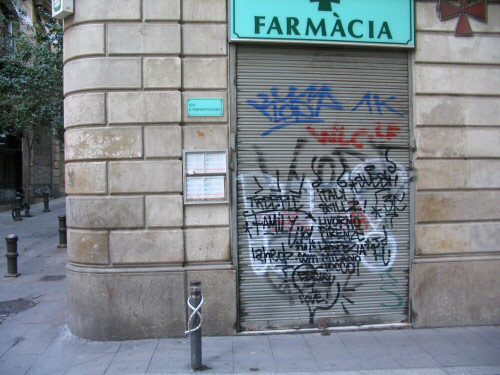
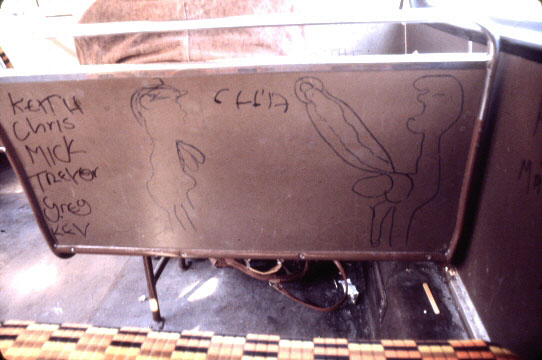
(pic 25-12-2006)
It seems as if an english group are
boasting their presence and allegiances in Barcelona - one person writing for all ?
or individually sharing the same spray-can ?
.
(pic 1982)
Expressing and advertising an extraordinary degree of identification of person with penis and a
bizarre degree of ignorance of the body that is its target, this savage image of
selfhood is nevertheless endorsed by six boys and aimed at one girl
(... one shudders !).
Perhaps
the most basic level of 'political' graffiti. Around this time, phallic
images (of various degrees of abstraction - a simplification
driven by a desire to 1: achieve an iconic stereotype; 2: the satisfaction
of drawing a perfectly fluent line; 3: a sufficiently rapid finish to
avoid
embarrassment
or arrest) were a frequent graffiti subject. Unlike this unusually anatomically elaborated and
sensation driven drawing with its direct report
of sexual urgency, the most common type of phallus image was no more than a
practiced automatic sign, presumably
a mere reassurance of renewable potency [see
examples].
.

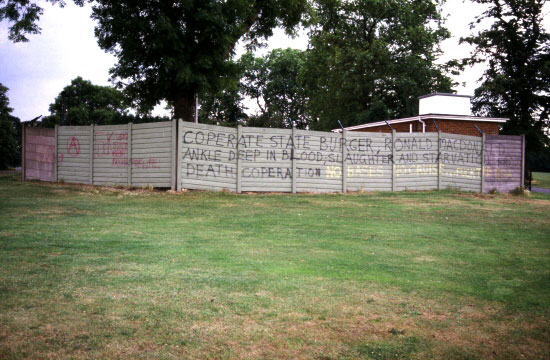
(pic 1984)
Around
this time an Anarchist group based in Brixton were vehemently politically
motivated. Their insignia tag here points the way to large text statements
inscribed on a facing fence [see next pic]. The familiar Anarchist sign of an
A in a circle is here combined with elements from the old symbols for
female and male - the female cross under the circle, the male arrow
diagonal from its upper-right. Does this signify sex solidarity? However,
strangely the male sign is shown bent and dripping - is this humor; a
woman's derision; a man's attempt to empower
the sign's abstraction?).
Encountering
such presentations via this culture's familiar context of sophisticated
publicity mores, exposes a startling disproportion between their style,
competence, subtlety, persuasiveness, mental-state, and the huge and
complex issues they purport to confront - or does their 'style' directly
express and intentionally speak to feelings beyond subtlety, of a state
reduced by prevailing powers to brutal desperation?
.
(pic 1984)
The
'Anarchist' pavement signs directed one to these large inscriptions, which
convert a park-workers' enclosure into an instructive hoarding.
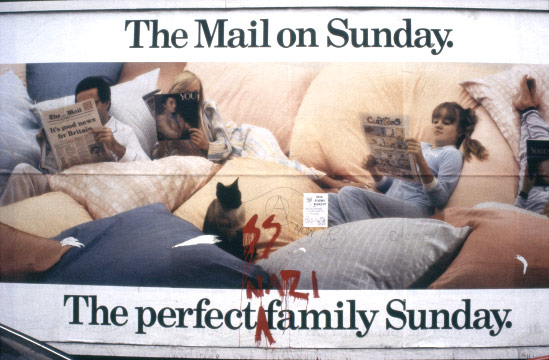
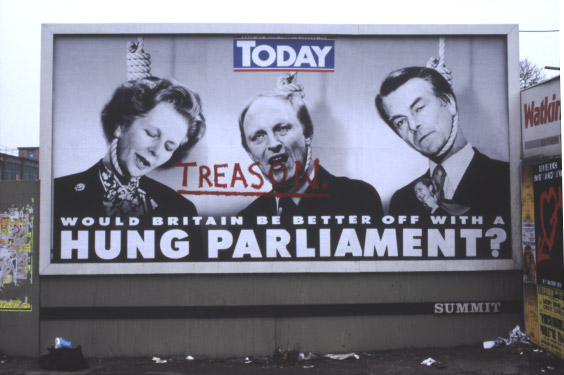
(pic 1985)
Various additions - the main tag is probably by Anarchists.
.
(pic 05-1987)
...
in process
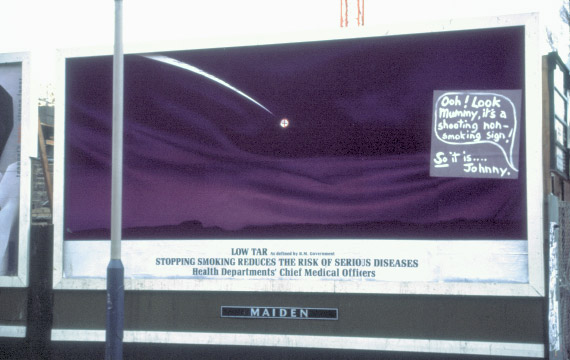
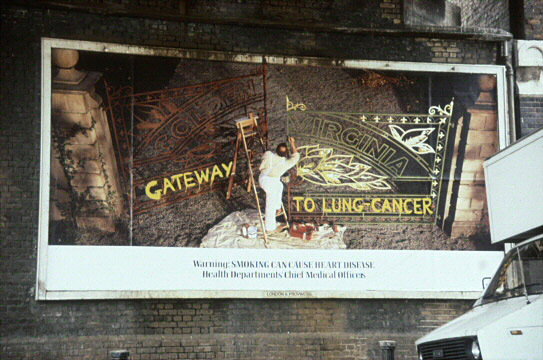
(pic 1989)
...
in process
An anti-smoking
amendment has been added to this ad. An ineffective because arbitrary change
of subject-matter.
.
(pic Summer 1987)
.
An anti-smoking
amendment has been added to this ad.
An inspired opportunism - a far more subtle and affective subversion than the
rather arbitrary appropriation of the previous ad.
Indeed, the added message
so perfectly fits the forms of the ad's designed message that its reversal
of intention seems completely innate.
A
painter is enhancing (with the brand's colours) a gateway which opens to my desire to
smoke - it's now been made to appear that he has already added - indeed it seems the ad was
designed to announce - that this gateway also leads to lung cancer. The
ad's original intention was probably to subliminally suggest that a Golden
Virginia cigarette would revivify an otherwise depressing entry into one's immediate dreary
future - however the added message flips the dreary driveway into a darkly sinister
region.
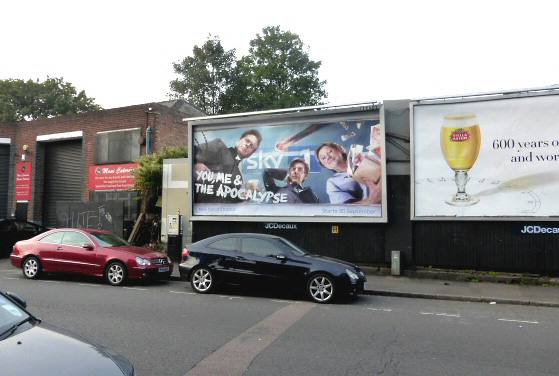
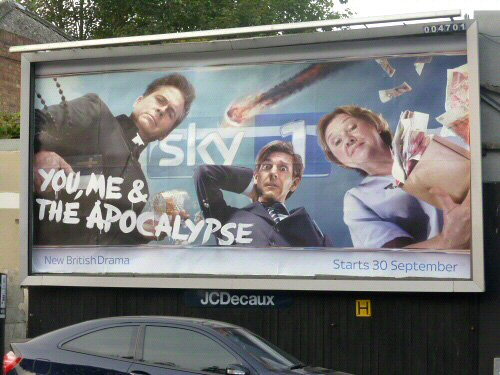
(pic 04-10-2015)
26 years later and 'the tables have
turned'. No longer 'defaced' by 'citizen belief groups' protesting against
advertised products - this 'tag' is intentionally incorporated in the ad as an
active 'trigger' for a product of a huge established media company. Tagged messages defacing ads and walls
have become so familiar that this pretend/designed/printed version lends a
credence of immediate reality and external public endorsement to a fantasy TV drama.
.
(pic 04-10-2015)
Though
reduced via years of tagging-familiarity, the shock detonated by the initiative
of a (supposed) private and extant individual (eg: perhaps an 'evangelical')
impacting a vast and location-less organisation's image, is not only an
experientially immediate attention-grab but poises the Sky-1 fantasy drama in a
crucial juxtaposition with the real external world (whose memory of the 2013
Chelyabinsk meteor - fed by local motorists' dash-board videos, and which the
ad's painted bolide resembles - was presumably still extant but waning).
.
I
start this selection of graffiti with the most primitive and urgent
of in-public-self-advertising - almost seamlessly close to the
social/territorial messaging of tagging. This function of territorial claiming
and the social-mutuality of in-public personal messages are at the inception
of unsponsored 'public-art'.
.
4:
'GRAFFITI' - TYPE-2: LOCATIONAL
ELABORATION VIA PICTORIAL / CONCEPTUAL TRANSFORMATION OF ITS SITE
... in process
Prior
to consulting the graffitists as to their intentions, the examples in this category
(and indeed, in some respects the category itself) are based on my subjective judgments.
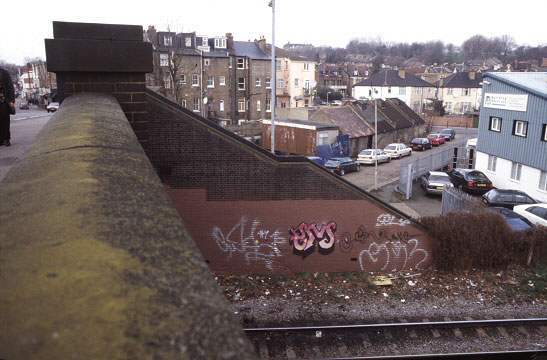
|
|
|
GRAFFITI
PLUS LOCATION:
RAILWAY BRIDGE NW WALL, LADYWELL STATION, LONDON
. |
GRAFFITI
PLUS LOCATION: VIEW FROM TRAIN
PLUS GRAFFITI ON RAILWAY VIADUCT WALL, JUST SOUTH OF LONDON BRIDGE
STATION, LONDON
|
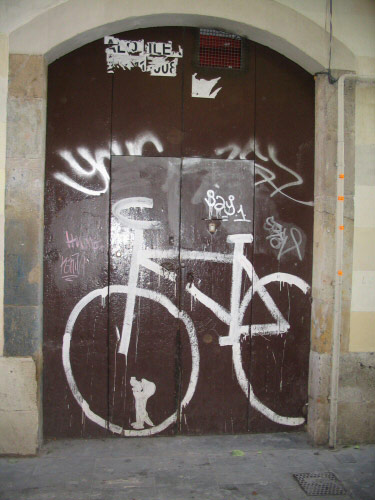
|

|
|
GRAFFITI PLUS LOCATION: ON DOOR, BARCELONA (OLD TOWN)(pic 31-12-2006) ... in process A bicycle appears to be emerging from a street door - affording a curiously unsettling sense of its sentient independence!. (Various tags and stickons have been added and obscured.) . |
TAGS
PLUS LOCATION:
A 'DOOR OF DOORS' ENTRY, BARCELONA (OLD TOWN)
. |

|
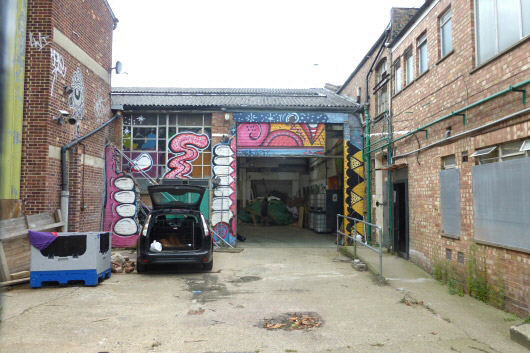
|
|
GRAFFITI
PLUS LOCATION: ART
STUDIOS ENTRY, STOUR RD (E), LONDON, E3 |
GRAFFITI
PLUS LOCATION: ART
STUDIOS ENTRY, STOUR RD (E), LONDON, E3 With the shutter raised there is minimal pictorial challenge to entry. . |

|

|
|
GRAFFITI
PLUS LOCATION: STIG - 21A GRIMSBY
ST, (SE-CNR) LONDON, E1 |
GRAFFITI
PLUS LOCATION: NOIR - "CARGO" CAFE, 79 RIVINGTON ST, LONDON, EC2 |

|

|
|
GRAFFITI
PLUS LOCATION: LOCKSMITHS DOOR - BETHNAL
GREEN RD., LONDON, E1
|
GRAFFITI
PLUS LOCATION: LOCKSMITHS DOOR - BETHNAL
GREEN
RD., LONDON, E1
|
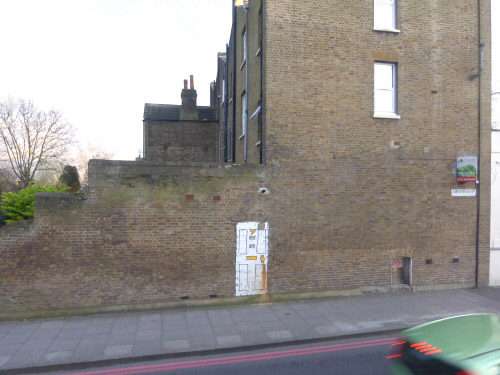
|

|
|
GRAFFITI
PLUS LOCATION: SPOOF DOOR - AMERSHAM
RD. (HOUSE 107 LEWISHAM WAY), LONDON, SE14
A bricked-up doorway - its presence signalled only by its original brick lintel - has been 'restored'. The fantasy is extended and the 'reality' of the pretence endorsed by the real peculiarity of its neighbouring tiny 'through the looking-glass' pavement-level window-oddity. The concluding strangeness is that the whole ensemble is overlooked and apparently entitled 'idyll' by an "Eden estates" logo that surmounts the location's name. . |
GRAFFITI
PLUS LOCATION: SPOOF DOOR
- AMERSHAM RD.
(HOUSE 107 LEWISHAM
WAY), LONDON, SE14, LONDON, SE14
. |

|

|
|
GRAFFITI
PLUS LOCATION: WALL WITH GAS-METERS - 7A TURVILLE ST., LONDON, E1
|
GRAFFITI
PLUS LOCATION: WALL WITH GAS-METERS - 7A TURVILLE ST., LONDON, E1
|
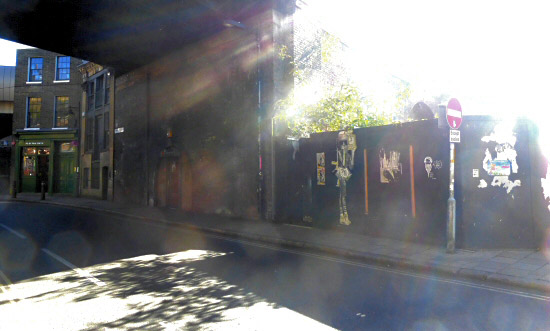
|

|
|
GRAFFITI
PLUS LOCATION: WC - BOROUGH MARKET, PARK ST. (E-END - NEAR REDCROSS WAY),
LONDON,
SE1
|
GRAFFITI
PLUS LOCATION: WC - BOROUGH MARKET, PARK ST. (E-END
- NEAR REDCROSS WAY), LONDON, SE1
|
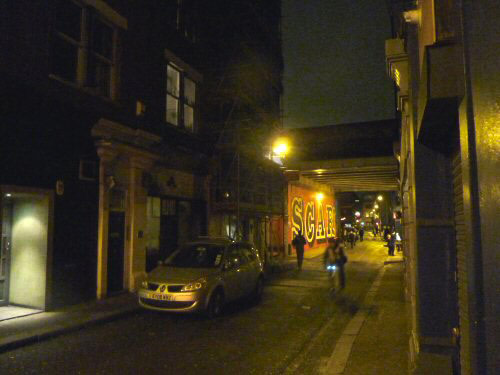
|
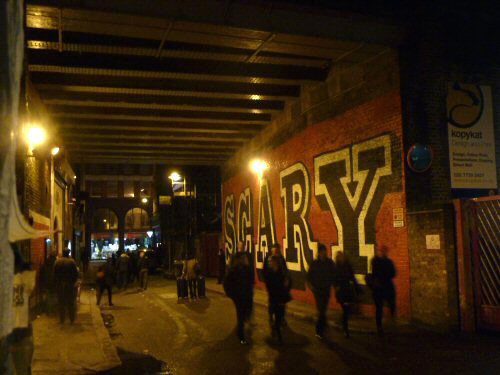
|
|
GRAFFITI
PLUS LOCATION: BEN
EINE - RIVINGTON ST, LONDON, EC2 As one enters, from Shoreditch High Street, this (at night) slightly sinister dark street, the most visible object (lit by the rail bridge lights and facing a night club entry) is this huge word: "SCAR". However, on approach it reveals another letter, hidden by a strange change of angle in the 19thC bridge wall, and the word transmutes to "SCARY"! The sophistication of this person's works suggests he is aware of such meaning-affecting potentials of locations. . |
GRAFFITI
PLUS LOCATION: BEN
EINE - RIVINGTON ST, LONDON, EC2 |
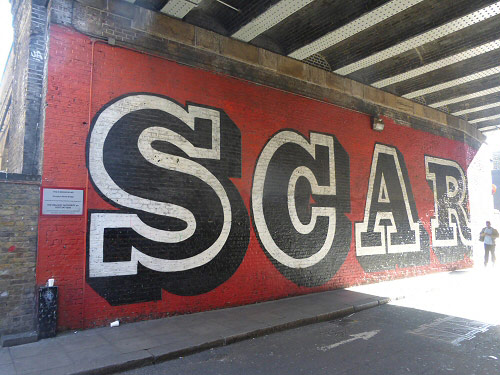 |
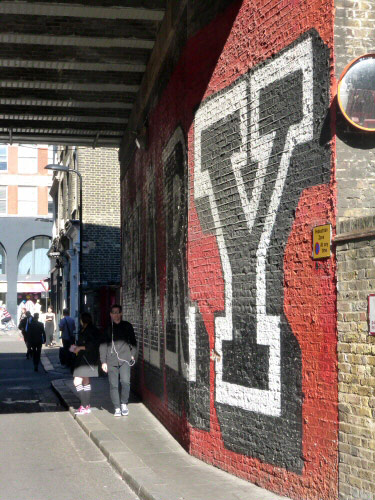
|
|
GRAFFITI
PLUS LOCATION: BEN
EINE - RIVINGTON ST, LONDON, EC2 |
GRAFFITI
PLUS LOCATION: BEN
EINE - RIVINGTON ST, LONDON, EC2 |

|
|
|
GRAFFITI
PLUS LOCATION: BEN
EINE - EBOR ST, LONDON, E1 |
|

|

|
|
GRAFFITI
PLUS LOCATION: BEN
EINE - EBOR ST (N-END), LONDON, E1 |
GRAFFITI
PLUS LOCATION: CRAIG
WARD: "MAKE IT" - "SQUARESPACE", EBOR ST (S-END), LONDON, E1 |

|

|
|
GRAFFITI PLUS LOCATION: SCULPTURED EAR & NOTICE - BRICK LANE & WOODSEER ST, LONDON, E1 (22-10-2013 / to NE) |
GRAFFITI PLUS LOCATION: SCULPTURED EAR & NOTICE - BRICK LANE & WOODSEER ST, LONDON, E1 (22-10-2013 / to NE) |

|
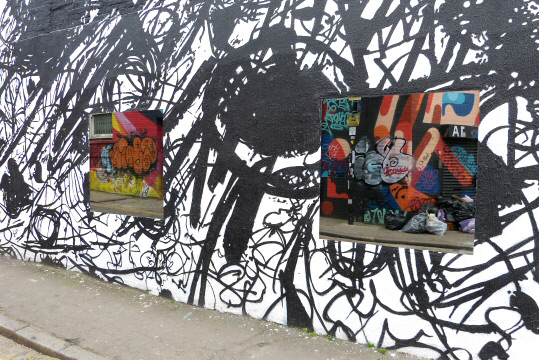
|
|
GRAFFITI PLUS LOCATION: HOUSE - CHANCE ST & WHITBY ST, LONDON, E1 (paste-up
2-pics 26-03-2018 / to NE) |
GRAFFITI PLUS LOCATION: HOUSE - CHANCE ST, LONDON, E1 - W FACADE WINDOWS (pic
26-03-2018 / to EEN) |
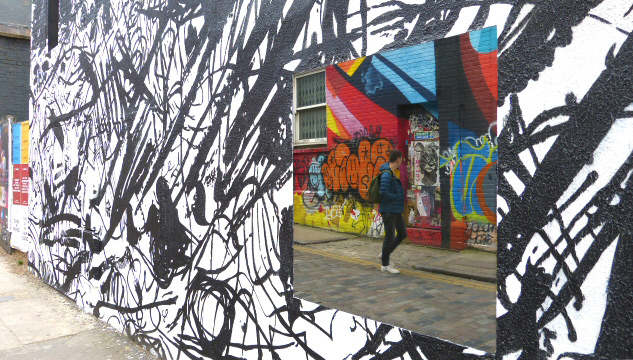
|
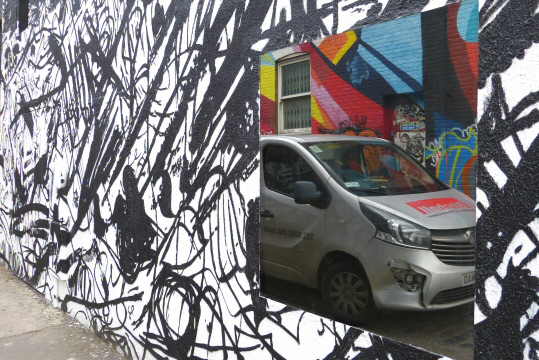
|
|
GRAFFITI PLUS LOCATION: HOUSE - CHANCE ST, LONDON, E1 - W FACADE N WINDOW (paste-up
2-pics 26-03-2018 / to NE) |
GRAFFITI PLUS LOCATION: HOUSE - CHANCE ST, LONDON, E1 - W FACADE N WINDOW (pic
26-03-2018 / to NE) |

|
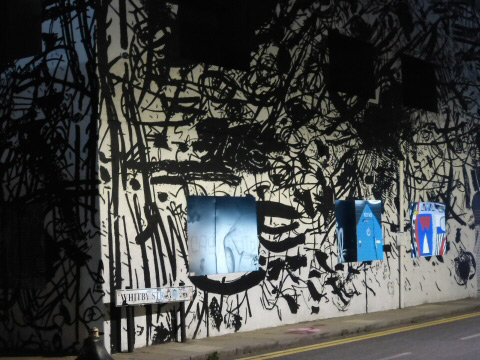
|
|
GRAFFITI PLUS LOCATION: HOUSE - CHANCE ST & WHITBY ST, LONDON, E1 - W & S FACADES AT NIGHT (pic
13-09-2018 / to NE) |
GRAFFITI PLUS LOCATION: HOUSE - WHITBY ST, LONDON, E1 - S FACADE AT NIGHT (pic
13-09-2018 / to NNE) |

|
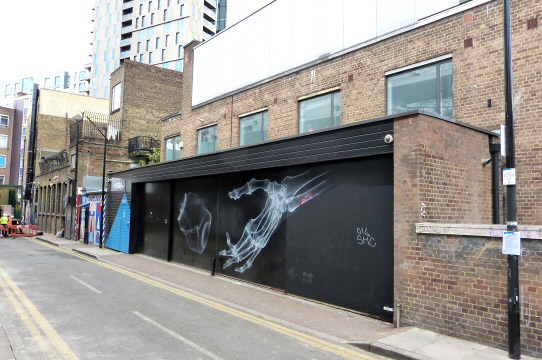
|
|
GRAFFITI PLUS LOCATION: HOUSE - WHITBY ST, LONDON, E1 - S FACADE WINDOW (pic
26-03-2018 / to NE) |
GRAFFITI PLUS LOCATION: FACADE OPPOSITE HOUSE - WHITBY ST, LONDON, E1 (pic
26-03-2018 / to SE) |
5: 'GRAFFITI' - TYPE-3: 'STREET-ART' in process
Increasingly 'Graffiti' has grown a branch where competitive self-assertion seems diminished and pictorial subject matter has escaped from its origin and bondage of evocatively rendered words. This emphasis on and freeing of the pictorial 'story-telling' aspect (even relegating its word origin to a signature (a tag!) in the corner of a pictorial 'art-work') has transmuted tagging & graffiting from affective and personal 'street-assertion' to effective and informative 'street-art'. This transformation has encouraged a new type of 'artist' into public performance; however, while infinitely extending its subject matter it has sadly begun to reduce the vitality of its impact (a vitality that is a correlative of fear), not least by assigning control of its 'messages' and their affectiveness to commissioning/sponsoring bodies (even Local Councils) and interested individuals (even middle-class house owners [Ref section 6]).
.
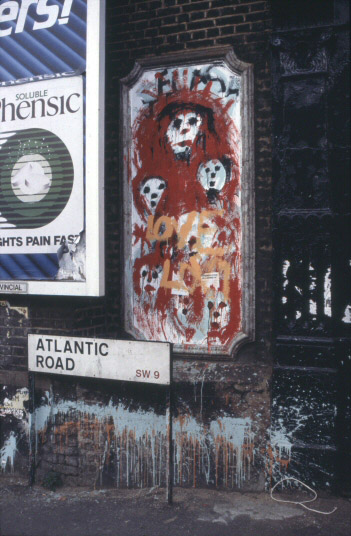
|

|
|
'STREET-ART'
:
RAILWAY VIADUCT WALL, ATLANTIC
RD, LONDON, SW9 A pictorial image that apparently has no 'meaning' except the direct affect of an individual's emotional expression. A strong event contributed to the street. .. |
'STREET-ART'
:
DOOR, BARCELONA (OLD
TOWN) |
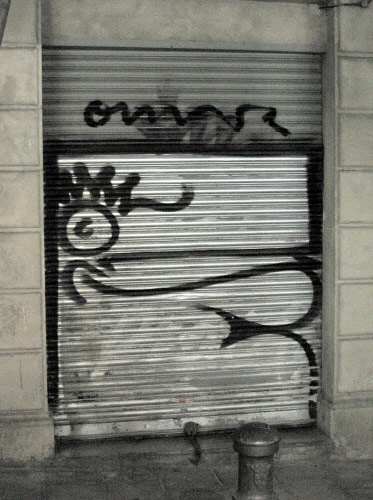
|
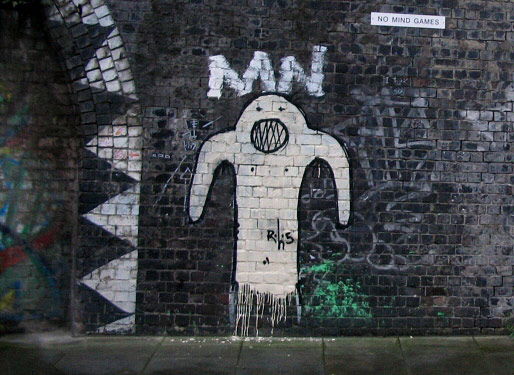
|
|
'STREET-ART':
METAL SHUTTER, BARCELONA (OLD TOWN)
. |
'STREET-ART' : RAILWAY VIADUCT WALL, GRIMSBY ST, LONDON, E2(pic 22-11-2006) A 'spook' - unpleasantly 'alive', or rather psychoactive, because the shape, though painted with a precision that requires definite intention, is indeterminate. One supposes it's a human figure (ready to waylay me at a murky corner of this somewhat lonely road), yet in closer view each of its features fails to definitely confirm this. The ensuing mental struggle to identify what it denotes (since our evolution insists we discover what confronts us) ensures that it seems to present something of the uncontrollability of an independently motivated entity. As if to confirm this objectivity, this entity appears to sprout from root-like dribbles whose form could only be determined by an agency completely separate from intention: gravitation. . |
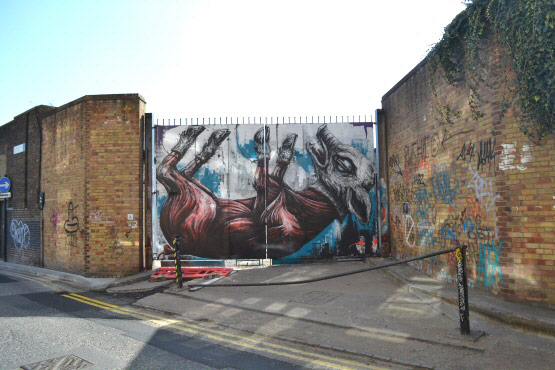
|
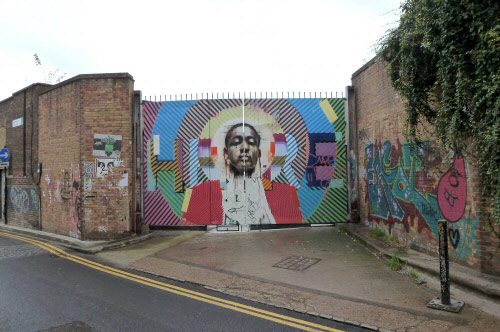
|
|
'STREET-ART':
ROA!
- INDUSTRIAL-YARD GATE, BUXTON ST., HACKNEY, LONDON, E1
|
'STREET-ART': POST-ROA!
- INDUSTRIAL-YARD GATE, BUXTON ST., HACKNEY, LONDON, E1 [ref previous pic] When I went to photograph it, about 18 months after ROA!'s photo, his extraordinary work had been overpainted with this modestly striking, but bland and commonplace image. One whose energy consists, not in an emotionally charged subject and the shock of an anomalous space, but in a relaxed enjoyment of moderate graphic-design skills serving a moderately successful formal cliché: a flat symmetrical pattern centrally focusing a 3D-rendered face. The difference is between the shock of original art and reassuringly illustrational decor. Graffiti works are frequently overpainted by other ambitious graffitists, however I wonder if this replacement was commissioned because the pig was too indigestible for the guardians of moderate enjoyment. . |
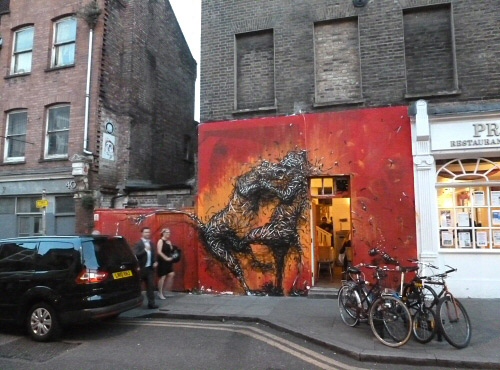
|

|
|
'STREET-ART': HANBURY ST (W END), LONDON, E1 |
'STREET-ART':
HANBURY ST (W END), LONDON, E1
|
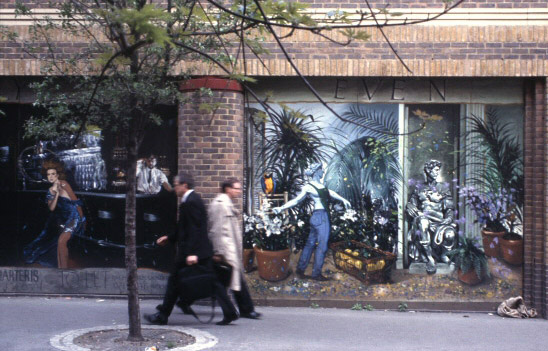
|
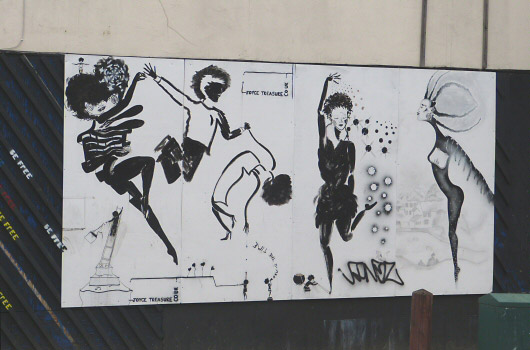
|
|
'STREET-ART':
HOARDINGS, MONMOUTH ST., SEVEN DIALS, LONDON, WC2 |
'STREET-ART':
HOARDING, 113 KIRKDALE, LONDON, SE26 . |
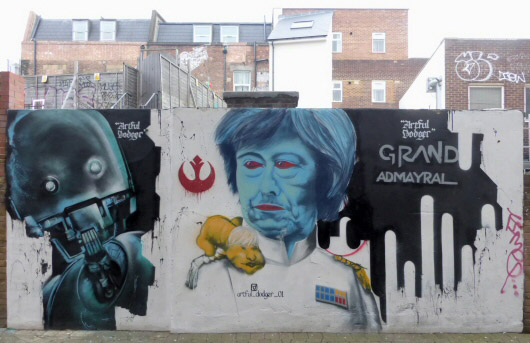
|
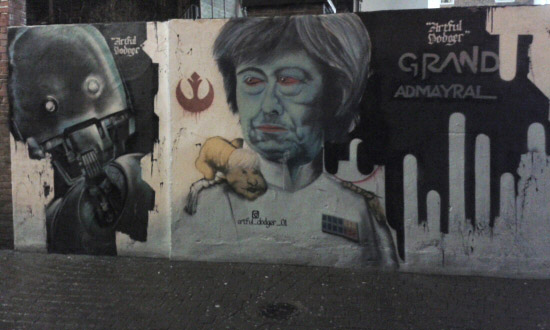
|
|
'STREET-ART': 'ARTFUL DODGER' - ALLY BESIDE
"PECKHAMPLEX" CINEMA, 95 RYE LANE., LONDON, SE15 |
'STREET-ART':
'ARTFUL DODGER' -
ALLY BESIDE
"PECKHAMPLEX" CINEMA, 95 RYE LANE., LONDON, SE15 |
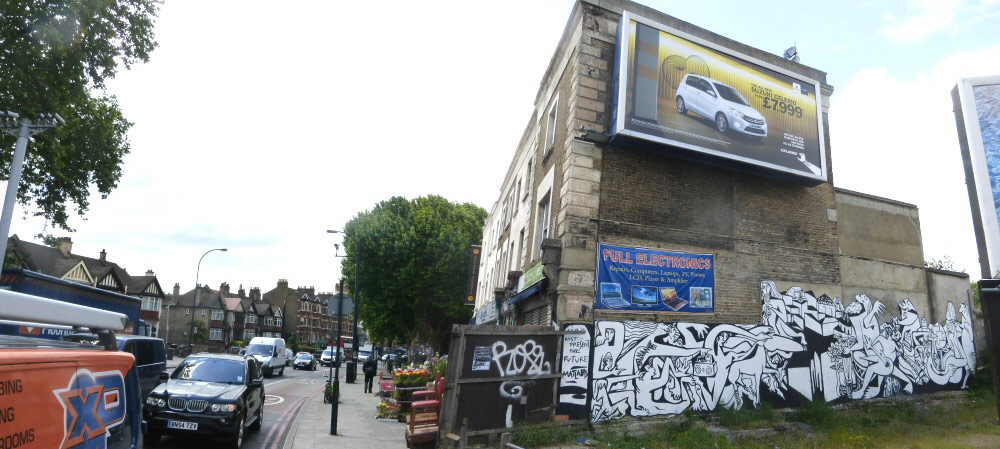
|
|
|
'STREET-ART':
RICCARDO MATLAKAS (02-2015) - NEW CROSS RD (W SIDE OF NEW CROSS GATE STATION), LONDON,
SE14 |
|

|
|
|
'STREET-ART': JIM VISION - '3-STREET MURAL' SE CORNER - CURTAIN RD & SCRUTTON ST, LONDON, EC2(paste-up 3-pics 25-09-2013 / to WWN) ... in process . |
|
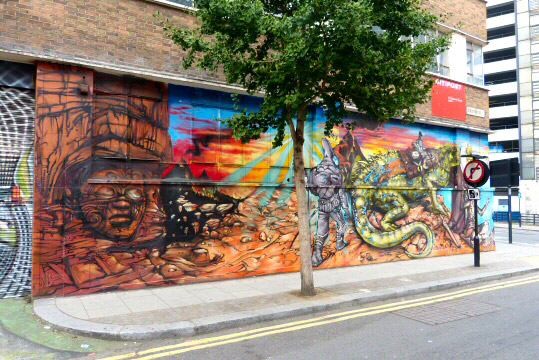
|
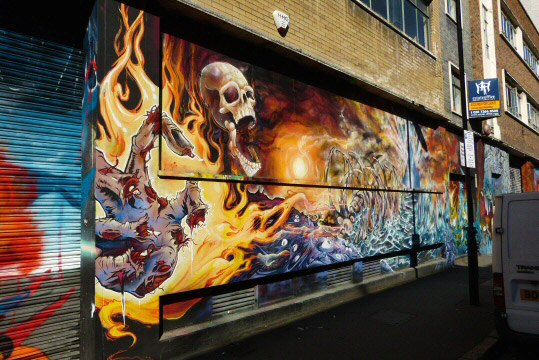
|
|
'STREET-ART':
JIM
VISION - '3-STREET MURAL' - SCRUTTON ST, LONDON, EC2 . |
'STREET-ART': JIM VISION - '3-STREET MURAL' - SCRUTTON ST, LONDON, EC2(pic 20-09-2013 / to NNE) - SCRUTTON ST, LONDON, EC2 ... in process . |
6:
GRAFFITI - PATRONAGE & DECADENCE
As usual [eg: squat-architecture], public interventions by citizens have at first the energy and confrontational presence of individualistic originative actions, they blossom on the public streets into a forest of affects and opinions. However, the works of some practitioners become recognisable and iconic, and eventually the target of 'collectors', commerce, and even leisure-flattering local councils. Unfortunately the pleasant warmth of this attention, and its concomitant image-filtering by their new sponsors and employers, has encouraged image-repetition and drained the creative energy of artists. Even the few most obviously talented, who have expanded their originations in size and location - emblazoning the planet's cities with their individualistic subject-matter - are becoming 'branded' via recognisibility and are thus slowly fosslising from lack of discovery and risk.
.
Like all originations the most useful and/or beautiful begin to be sifted by the public's cultural pundits and thereafter by its 'guardians of the norm'. Eventually makers of works deemed useful and beautiful begin to be tempted, by people who perceive their cultural/business potential, into 'profitable employment'. Thus the energy of solitarily forcing open boundaries of society's environments and freedoms of action is relinquished for praise and profit (the fate of many artists). This is, in some respects of course, a cultural-experiential tragedy: the products of innovation and freedom are differentiated and the 'best' are publicised and commodified; growing shoots of freedom are amputated and originality is re-absorbed back into tradition. It seems that many graffitists have become or been replaced by compliant converts to the cause of public entertainment and distraction, and the innovative aesthetic and social subject-matter potentials that graffitists released are being reduced to a mainly kitsch emphasis on a provision of decorative public paintings and a small widening of a tolerance of environmental colour.
7: GRAFFITI & STREET-ART STYLES ARE TRANSPOSED INTO COMMERCIAL & INSTITUTIONAL
USES ... in process
As the 'look' of graffiti becomes
familiar and even enjoyed, and is gradually accepted as an improvement of scarily
scruffy and chaotic areas of the city, the idea of fascinatingly daring 'edgy'
locations decorated/celebrated by the talented 'alternative-lifers' eventually
devolves, spinning off as it does so, low energy, partially
tamed, stylised and bowdlerized versions of itself, sold both
as portable art and commissioned
painted decorations, designed (not improvised) for even
quite ordinary suburban places. Such images must be commodifiable
and their 'excitement' salable - their visual styles relatively familiar and quotable
... such 'graffiti' has reached a terminal stage of consumer assimilation.
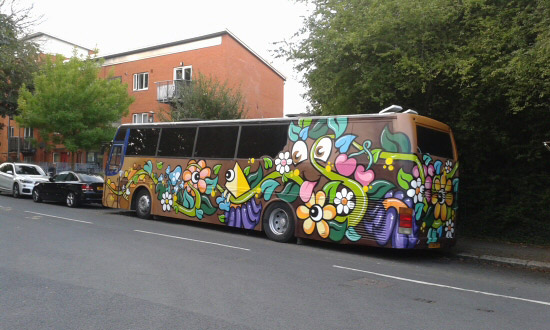
|
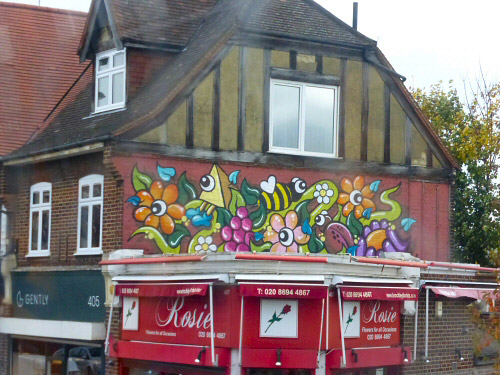
|
|
POST-GRAFFITI: ARTISTA - DECORATED COACH - BROCKLEY WAY, LONDON, SE23(pic 14-08-2017) Graffiti seems to have exuded cultural permission to cover ordinary functional objects in 'painterly' patterns. Here are two examples of a 'street-art' painter's work which seems to inherit graffitiesque characteristics: swirling rhythms, dense compositional coverage, lavish colour, subject-matter consisting of a mix of repetitious motifs, a mix of rational and irrational elements. However they manifest almost nothing of `graffiti's energy, presence, freedom; none of its origination excitement, urgency of execution, daring, innovative liberty. These images are cloyingly sentimental, aesthetically insensitive, monotonously repetitive, embarrassingly childish, as predictable and unexpressive as product-branding graphics, commercially rather than personally aspirational. . |
POST-GRAFFITI: ARTISTA - DECORATED
SHOP BUILDING
- BROCKLEY ROAD, LONDON, SE23
|
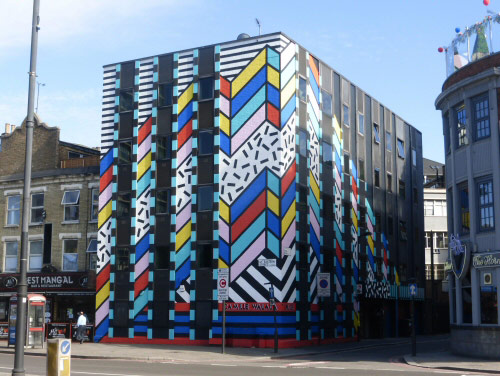
|
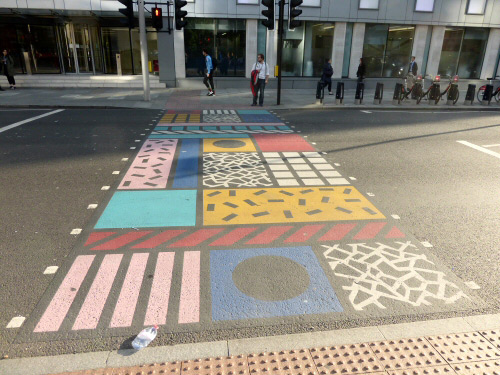
|
|
POST-GRAFFITI: CAMILLE WALALA
(c 04-2015) - "SPLICE", GREAT EASTERN ST.
& SANGER ST., LONDON, EC2 |
POST-GRAFFITI:: CAMILLE WALALA
(16-09-2016) - PEDESTRIAN CROSSING, SOUTHWARK ST., LONDON, SE1 |

|

|
|
POST-GRAFFITI: ESTATE
AGENTS OFFICE, REDCHURCH ST. (E-END) & BETHNAL GREEN RD., LONDON, E2 |
POST-GRAFFITI:
"THE TRAMPERY", 239 OLD ST., LONDON, EC1 |
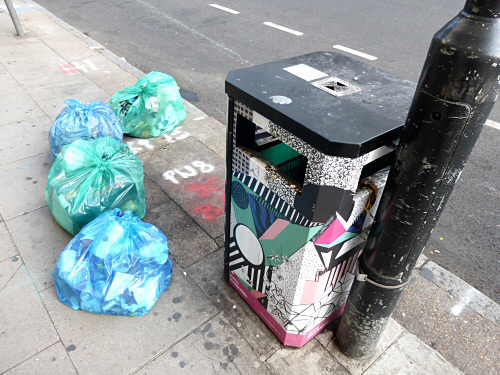
|
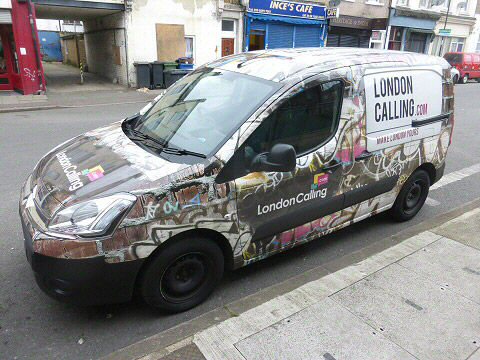
|
|
POST-GRAFFITI: "BETTER
BANKSIDE" WASTE-BIN, SOUTHWARK ST., LONDON, SE1 |
POST-GRAFFITI: A COMMERCIAL
VEHICLE IN A SUBURBAN STREET,
LONDON, SE23 |
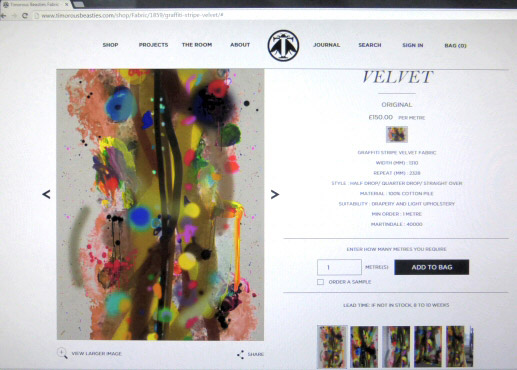
|
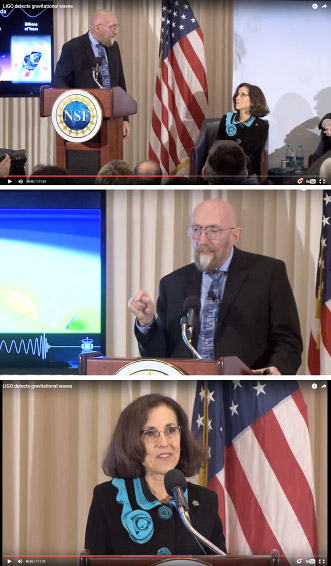
|
|
POST-GRAFFITI: COMMERCIAL FABRIC CATALOGUE
- WEB VERSION |
LIGO:
1st GRAVITY-WAVE DETECTION - NATIONAL SCIENCE FOUNDATION (USA) PRESS-CONFERENCE
- 11-02-2016 - VIDEO:
(pic 11-02-2016)
Kip Thorne (LIGO co-founder / Caltec) - themed tie. France Cordova (Director: National Science Foundation, USA) -
'possibly themed' jacket. |
.
IMPROVISED ARCHITECTURE IN AMSTERDAM INDUSTRIAL SQUATS & COLLECTIVES AN
ARTIST'S
PUBLIC-SITE INSTALLATION WORKS
IMPROVISED
OPEN-SITE: ("THE NOMADIC COMMUNITY GARDEN")
IMPROVISED VILLAGES: (WANDSWORTH & KEW BRIDGE 'ECO VILLAGES')
ALLOTMENT
IMPROVISATIONS - PUBLIC, LEGAL, SOCIALLY INDORSED TEMPORARY-ARCHITECTURE:
("FRANK'S CAFE" & "SOUTHWARK LIDO")
VERNACULAR - PRAGMATISM & STYLE: (BERDUN VILLAGE BARNS & HOUSES) "HOME"
- MY LOCATION VIA MASS-PRODUCTS & TASTE - LIV-RM
"HOME" - MY LOCATION VIA PERSONAL
CHOICES
ART - GOTHIC INTO RENAISSANCE INTO EARLY 20thC
ART - 20thC COLLAGE INTO MASS-MEDIA GRAFFITI INTO STREET-ART
.
"HOME" - MY LOCATION VIA MASS-PRODUCTS
& TASTE - HOUSE
KITSCH
CHANCE
& DESIGN